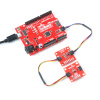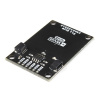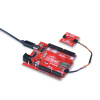Radio Frequency Identification, or RFID, has been around in some form since the mid 1940s. Léon Theramin’s listening device for the Soviet Union and Sir Robert Alexander Watson-Watt’s Identify Friend or Foe (IFF) system were both developed and used during WWII as early examples of using radio frequency to identify objects.
Today, we use RFID technology for everything from office security and access control, to high speed roadway toll payments, to hospital infant tracking, to race timing. The list of applications is extremely long, but they all come down to the same three things - an RFID tag, an RFID reader and a computer or microcontroller to control what happens with the information.
With Automatic Identification and Data Capture (AIDC) devices and technology racing forward, now is a great time to start working with RFID devices. Can you imagine going to the supermarket, filling your cart, and then just walking out as an RFID reader captures the information from the tags on every one of your items? It may sound a bit futuristic, but right now our Simultaneous RFID Reader is capable of reading up to 150 tags per second. Pair that with the proper antenna, and you’ll get a reading range of almost five meters! Not only does that make it seem like checkoutless shopping might not be too futuristic, but it sounds like you might even be able to create that type of system yourself!
Getting started with RFID is as easy as taking candy from a... candy vending machine.
If you’re new to RFID, this video will give you a brief overview, plus show you a recent RFID project I put together with just a few Qwiic boards, a servo, and a quarter-dozen LEDs. Then head over to our RFID page for more ideas and inspiration! And if you have an amazing RFID project, or even an amazing idea for one, we want to hear about it in the comments!
Happy Hacking!

Interested in more RFID?
We've got a page just for you! Get an overview of the basics of how RFID works, the hardware needed and tutorials to get you started.










Yes. XD
Cute video, Rob!
FWIW, I recall having a credit-card sized RFID tag back in the mid-70s when I was working in a factory that would gain access to certain "restricted" parts of the factory. They seemed like "PFM" (Pure Magic) at the time.
My next encounter with RFID was that the college library a few years later had tags in all the books, and scanners at all the exits. If you had a book that hadn't been checked out, it would sound alarms. When you checked out a book, they'd pass it over some sort of device that set some flag saying it was OK to pass through the scanner gate. My understanding was that when a book was "returned", it got passed over another device so it would then set off the alarm again. Since your personal books (e.g., text books) didn't have tags, they wouldn't set off the alarms. I never did find out much about that system, as my stint of taking "library science" (in lieu of PE, which I had a doctor's excuse for) in high school was well before this was common in libraries. (I had to type up many cards for the card catalog...)
That library likely didn't use RFID, unless they were also using it to check in/out books electronically without scanning a barcode or using a paper slip. More likely, they were using an electromagnetic security system, similar to what you see in retail stores for high value items. The tag and the detector is simpler and less expensive.
Instead of a programmable microchip with a unique identifier, an EAS (electronic article surveillance) system tag uses two simple magnetic strips. The detector puts out a low frequency magnetic signal that causes the strips to vibrate against themselves, putting out a signal that the detector can pick up. The tags can be magnetized/demagnetized to prevent or allow this vibration, allowing an item to pass through silently or to trigger the alarm.
In a retail setting, they normally only deactivate (magnetize) the tag by passing it over a device at the checkout. But in a library, they can easily turn a book's tag on (demagnetize) or off (magnetize) when it is checked in and out.